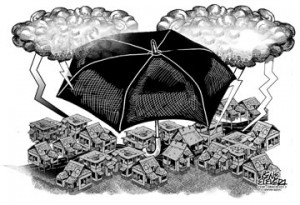Tested by the storm

For the third year, strong storms have battered the country in the last quarter.
Scientists say that with climate change, more intense and more frequent extreme weather events is the new normal.
The world is heading toward the end of the 10-year Hyogo Agreement which aims to build nations and communities that are resilient. The United Nations Strategy for Disaster Reduction provided the roadmap for a strategic and systematic approach to reducing vulnerabilities and risks.
The Hyogo Framework 2005 underscored the need for, and identified ways of, building the resilience of nations and communities to disaster.
In compliance with the Hyogo Agreement, the Philippine government enacted in 2010 Republic Act 10121 or the Disaster Risk Reduction and Management Act.
Article continues after this advertisementThe main principles of disaster risk reduction (DRR) are the acceptance of the reality that natural and man-made disasters do occur and that impacts can either be prevented or mitigated.
Article continues after this advertisementOne of the most important but tricky parts of DRR is building resilience. While resilience is latent in individuals, groups, communities and the nation as a whole, the degree of resilience to extreme, mostly life threatening events, varies.
Resilience is simply the ability to survive danger. If a man lives in a coastal area, storm and tidal surges are given risks. Building resilience gives him the capacity to run away from the wave surges. If running away is not an option, building a seawall or building houses on stilts mitigates the impact, increasing his chances of survival.
In the past two days, government agencies from all levels, communities, households and individuals have done their share in preparing for the onslaught of Typhoon Yolanda. This is a good sign.
Going to a grocery to buy basic supplies ahead of a storm is not panic buying as many, including some media outlets, have called the exercise.
This is part of preparedness. Panic buying happens when people hoard or go on irrational buying sprees beyond their level of need.
Local governments and disaster frontline agencies are doing their part too.
We hope and pray that damage to life and properties will be minimal as Yolanda arrives.
And hopefully, when Yolanda is done battering the country, government will seriously invest in flood control infrastructure and communities start behaving with more civic responsibility by not clogging waterways with garbage.
Before we pick ourselves up, nothing will be lost if we kneel a little longer to pray.